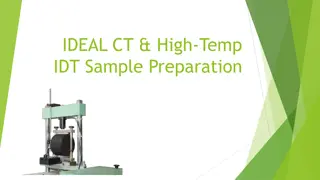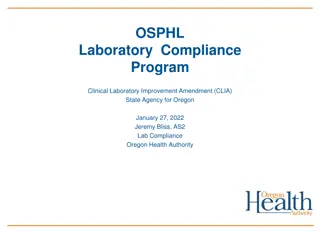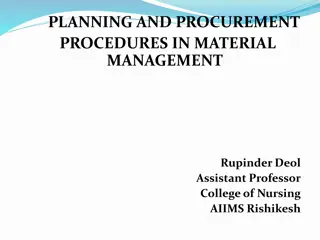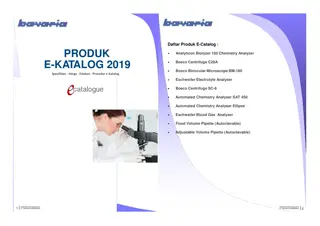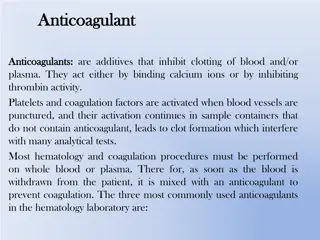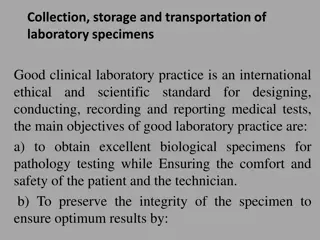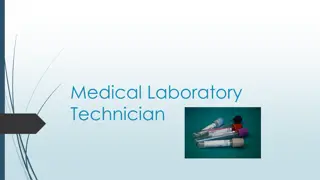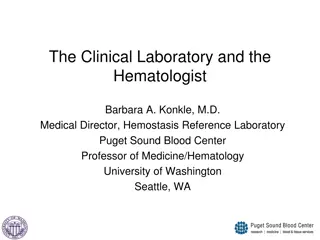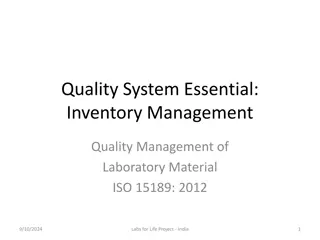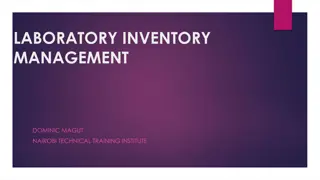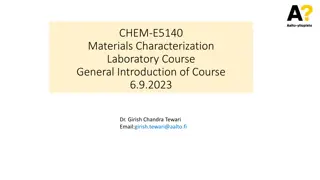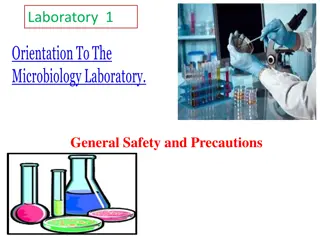Laboratory Material Quality Management Procedures
This detailed guide covers the comprehensive process management and quality control procedures for laboratory materials, including the life cycle of materials, purchase processes, vendor evaluation, reception and storage guidelines, and evaluation criteria. It emphasizes the importance of documented procedures, supplier evaluation, and proper handling from procurement to disposal to ensure quality and safety in laboratory operations.
Download Presentation

Please find below an Image/Link to download the presentation.
The content on the website is provided AS IS for your information and personal use only. It may not be sold, licensed, or shared on other websites without obtaining consent from the author.If you encounter any issues during the download, it is possible that the publisher has removed the file from their server.
You are allowed to download the files provided on this website for personal or commercial use, subject to the condition that they are used lawfully. All files are the property of their respective owners.
The content on the website is provided AS IS for your information and personal use only. It may not be sold, licensed, or shared on other websites without obtaining consent from the author.
E N D
Presentation Transcript
Process management Quality Management of Laboratory Material
Life Cycle of Materials 1. Purchase of Materials or Services 2. Supplier Evaluation 3. Reception of Material 4. Storage of Material 5. Labeling 6. Acceptance Testing 7. Usage 8. Safety and Adverse Incident Reporting 9. Disposal of Unused And Expired Material 10. Documentation
Purchase of materials or services The ISO 15189: laboratory must have a documented procedure for the selection and purchasing of external services, equipment, reagents and consumable supplies that affect the quality of its service Does your lab have a QSP for purchase?
Purchase Documented procedure Solicitation of bid Bid evaluation Vendor Selection Agreements Agreement review and amendment Vendor Evaluation Approved supplier list (Lab / State)
When and How to evaluate At least annually Objective scoring to be given If the goods have been delivered in acceptable condition If orders are full and complete If complaints are handled appropriately Ability to provide goods with adequate expiry dates Willingness to replace failed lots that were verified at a later date from the date of goods receipt. Abiding by the rate contracts Change of distributers if the rate contracting is with the manufacturers; and prior information thereof so as to avoid disruptions Ability to maintain supply of diagnostics at specified temperatures during transit
Reception of Material verify contents check integrity record date each item received check temperature requirements record expiration date Document
Store in a: In a dry place In a well-ventilated place In a closed container Locked up In a corrosive resistant container Protected from sunlight At temperatures not exceeding . Do not expose to temperatures exceeding (look at labels) Away from other material
Storage of Material Receiving location must have adequate storage and handling capabilities to maintain purchased items in a manner that prevents damage or deterioration (appropriate space, temperature, humidity and free from pests). The laboratory should store these received reagents and consumables according to manufacturer s specifications. Always follow hand-outs or product manuals for these details. Protocols for the same even when the laboratory is not the receiving facility
Storage of Material Designated storage and handling areas for materials to protect them from damage or deterioration. In accordance with the manufacturer s recommendations and any applicable safety requirements. The temperatures of refrigerators, freezers should be checked using calibrated thermometers and recorded as per lab policy Store new shipment behind existing shipment Create or update records
Onboard storage of Reagents Many automated equipment have facilities for storage of reagent onboard. There are cooling systems like peltier built in which will ensure that the reagent integrity is retained. However, such cooling systems should be supported by suitable ambient temperature. This might involve the need for continuous temperature control of the room where the equipment is housed. Onboard storage, if available, should be utilized since this ensures optimum performance of the reagents.
Stock Logbook Name and signature Date of receipt Quantity Date of expiry Minimum stock Stock balance Shelf number
Labeling The label should always contain information e.g. Content and quantity Concentration or titer Date received/prepared Date of opening Storage requirements Expiry dates, wherever applicable.
Usage, Kit inserts Instructions for use of reagents and consumables, including those provided by the manufacturers, should be readily available. All kit inserts should be logged. The in-use kit inserts should be stamped with controlled stamp. The old inserts should be stamped Obsolete and removed from the points of use.
Safety and Adverse incident reporting All reagents and chemicals should have Safety Data Sheets. The staff should understand the possible hazards and be trained on safety and precaution measures. Adverse incidents and accidents that can be attributed directly to specific reagents or consumables should be reported internally, investigated and reported to the manufacturer and appropriate authorities, as required.
Disposal of Unused And Expired Material As per the biomedical management rules 2016: Ensure segregation of liquid chemical waste at source and ensure pre-treatment or neutralization prior to mixing with other effluent generated from health care facilities; Cytotoxic drug vials shall not be handed over to unauthorized person under any circumstances. These shall be sent back to the manufactures for necessary disposal at a single point. As a second option, these may be sent for incineration at common bio-medical waste treatment and disposal facility or TSDFs or plasma pyrolysis is at temperature >1200 0C.
Disposal of Unused And Expired Material Residual or discarded chemical wastes, used or discarded disinfectants and chemical sludge can be disposed at hazardous waste treatment, storage and disposal facility. In such case, the waste should be sent to hazardous waste treatment, storage and disposal facility through operator of common bio-medical waste treatment and disposal facility only. Yellow colored containers or non-chlorinated plastic bags labeled with cytotoxic labels may be employed for this purpose.
Documents and Records Level 2 Procedures for purchase, verification, reception, storage, acceptance testing and inventory management of reagents and consumables.
Documents and Records Level 3: Identity of the reagent or consumable Manufacturer s name and batch code or lot number Contact information for the supplier or the manufacturer Date of receiving, the expiry date, date of entering into service and where applicable, the date the material was taken out of service Condition when received (e.g. acceptable or damaged) Manufacturer s instructions Records that confirmed the reagent s or consumable s initial acceptance for use Performance records like Internal Control records that confirm the reagent s or consumable s ongoing acceptance for use Adverse incident reports






